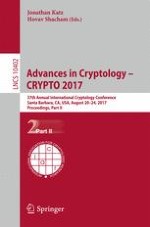2017 | OriginalPaper | Buchkapitel
Distinguisher-Dependent Simulation in Two Rounds and its Applications
verfasst von : Abhishek Jain, Yael Tauman Kalai, Dakshita Khurana, Ron Rothblum
Erschienen in: Advances in Cryptology – CRYPTO 2017
Aktivieren Sie unsere intelligente Suche, um passende Fachinhalte oder Patente zu finden.
Wählen Sie Textabschnitte aus um mit Künstlicher Intelligenz passenden Patente zu finden. powered by
Markieren Sie Textabschnitte, um KI-gestützt weitere passende Inhalte zu finden. powered by
Abstract
-
Two-round witness indistinguishable (WI) arguments for \(\mathrm {NP}\) from different assumptions than previously known.
-
Two-round arguments and three-round arguments of knowledge for \(\mathrm {NP}\) that achieve strong WI, witness hiding (WH) and distributional weak zero knowledge (WZK) properties in a setting where the instance is only determined by the prover in the last round of the interaction. The soundness of these protocols is guaranteed against adaptive provers.
-
Three-round two-party computation satisfying input-indistinguishable security as well as a weaker notion of simulation security against malicious adversaries.
-
Three-round extractable commitments with guaranteed correctness of extraction from polynomial hardness assumptions.
